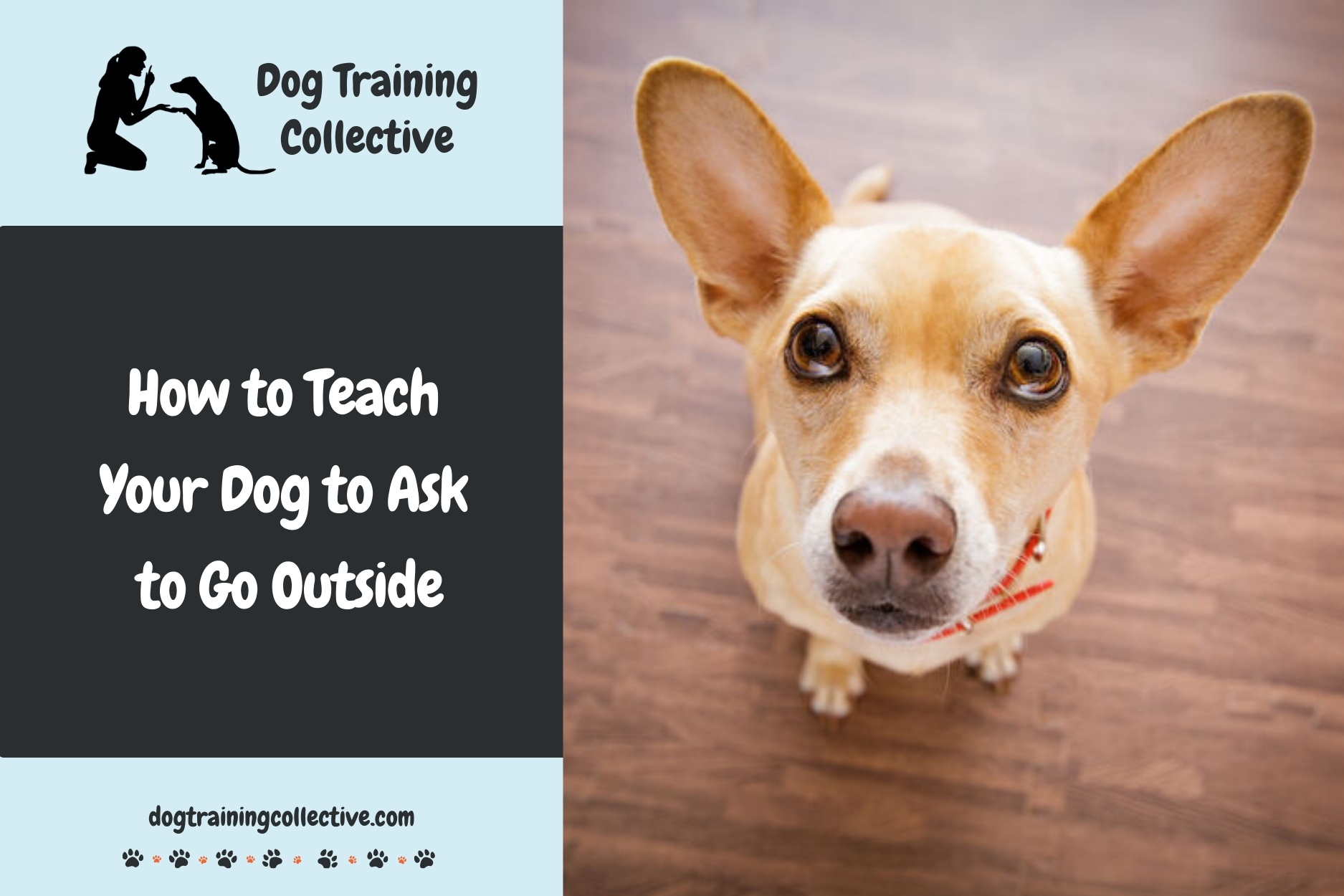Is your dog potty trained? That question alone can send most new dog owners into a spiral wondering when and how they should go about it. Wouldn’t it be nice if your dog could speak and just say, “I have to go to the bathroom.”? And perhaps even add an emphatic “Now!”
Unfortunately, he can’t. So, it is up to us owners to devise ways and means of helping our dogs regulate themselves in their doggie way without having to go overboard about holding their bladder in.
What Does It Mean When Your Dog Is Asking to Go Outside?
Other than playing, a dog would ask to go outside and go potty to relieve him or herself. He does this when he is already housebroken and can already avoid “accidents”. No more indiscriminate peeing whenever and wherever he wants. He can ask to go outside by either giving natural cues or trained signals like sniffing at the floor, barking and looking at the door, pawing at his owner, and perhaps even ringing a bell.
He would do this at a certain time of the day, mostly in the morning, in the afternoon, and sometime in the evening. These are some of the urgent reasons why your dog needs to go out.
Why Is It Important to Teach a Dog to Ask to Go Outside?
Aside from the fact that being potty trained is one skill that no dog can go without, it is indeed a requirement for any owner who wants to have a well-behaved pet who at least can be said to have already been trained for basic social skills. Otherwise, he will have all sorts of stinky troubles that would need constant cleaning up.
How to Train Your Dog to Ask to Go Outside: A Step-by-Step Guide
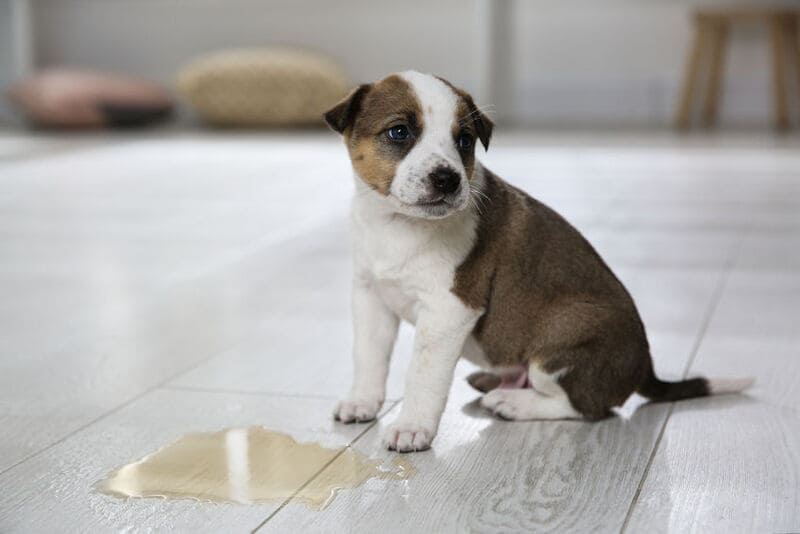
There are so many reasons that your dog may want to go outside, but for this guide, we will be catering to his need to relieve himself or go to the potty. There are two parts to this training, as follows:
- Part 1: Give Your Dog a Designated Potty Place
- Part 2: Teach Your Dog How to Ask You If He Needs to Go Out to the Potty
This training will be for the most part all about capturing the desired behavior. There is no direct command to go potty, only positively marking the desired behavior and some verbal praise.
The only difference is that aside from positively marking the desired behavior you will also have to negatively mark your dog’s “accidents” with an “Aah!” or “Hey!”, to let him know that he made a mistake. Interrupting your dog when he is having an accident will likely result in him holding out rather than finishing it.
In this case, you will want to gently mark him on the negative after the accident so that he doesn’t stop but will still know that he made a mistake.
Equipment you will need
- Treats and a treat pouch: His favorite dry kibbles will suffice for this training. No need for high-value treats since we are just trying to manage a natural occurrence and not correct it.
- A Good Quiet Place to Potty Train: Dog potty is quite a sensitive event. Minor distractions can set them off peeing everywhere, except for the place where you want them to. Or they will flat-out refuse to defecate because of uneasiness.
- Cleaning implements: You will have to expect to clean up a little bit of urine and doggie poo in the course of this training. And most likely, for the rest of your doggie’s life. Yup, it’s part of owning a pet. Don’t worry, it will all be worth it.
Part 1: Establish Regular Potty Habits for Your Dog in an Assigned Place
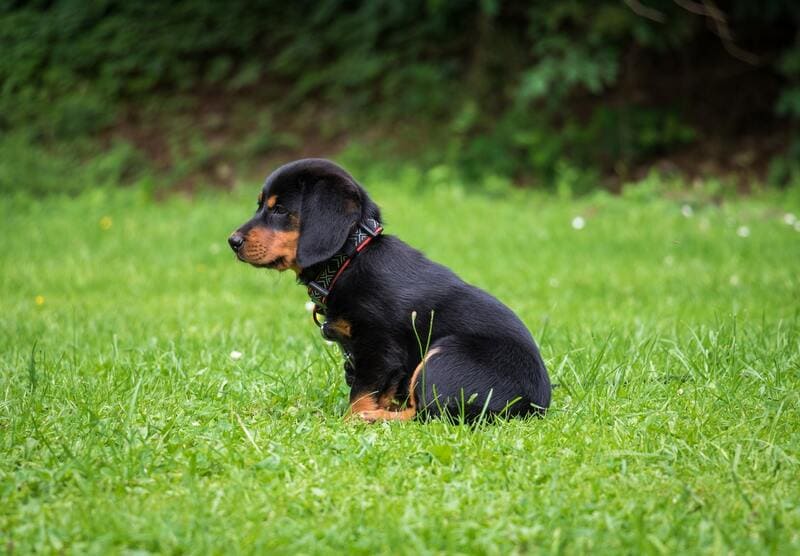
Step 1: Choose a Designated Potty Place for Your Dog
Find out from the breeder or the rescue center about where your dog might be most comfortable with doing potty. For example:
- Gravel
- Cement
- Any wide paper material
- Towels
- Grass
Step 2: Start Training When Your Dog Wakes Up in the Morning
Set your dog up for success by starting your training in the morning when he wakes up from his crate. What better way to be ready to eliminate body waste than in the morning after waking up? The goal is to at least potty regularly at the time that it is most likely to happen. You can’t expect it to happen like clockwork, but it should come within a certain period after waking up.
Step 3: Put Him on a Leash Outside of the House
Remove your puppy from the crate, or his bed and bring him outside of the house. While pretending to ignore him, stand around and wait for him to go potty or urinate. Do not coax your dog to go potty.
Pro tip
When taking your puppy outside, be sure to pick him up and carry him outside to make sure he doesn’t have any chance to pee or poo on the floor inside the house. After a few times of doing this, emphasize the habit by sometimes setting him down on the floor and waiting for him to look up at you and/or try to go to the door as if asking you to open it. Pick him up again and bring him outside. This way, you are already training him to ask you to open the door for him when he needs to go.
Step 4: Wait for Signs That Your Dog Needs to Go
As you stand around the designated place with your dog on the leash, try to be still and wait for the signals as you must recognize some of the natural signs. This way you will be able to use these signals as cues to open the door and allow him to do his thing.
Remember: The goal of part 1 is to help your dog remember his potty place and at least get the urge to do it there or want to go there if he needs to.
You will know that your dog wants to go when you see him give you signals in 2 ways:
Natural Signals
- some restlessness
- circling
- panting
- walking back and forth
- Sniffing
- Curving of the body
- Squatting
Trained Signals (signals that he will learn in training)
- Ring the bell
- Pawing at You
- Bark at you
- Going to the door and barking at you
Respond to his natural signals by immediately opening the door and or picking him up and carrying him to his potty place. Quickly open the door for him too when he does the trained signals.
If it is only the first few days of training, your dog will likely have “accidents”. Don’t get angry at him or her. Just do a negative marker like “aah” or “hey” with a very mild unapproving tone and clean up the mess. This is so that your dog will know that he has made a mistake. By the way, doing negative markers may backfire. So, observe if it does the job or not, otherwise, don’t use it all.
Try not to use cleaning agents that smell of ammonia or your dog might mistake it for urine and mark the accident. He’ll likely do it all over again at the same place where you don’t want him to.
Step 5: Build and Maintain a Routine

Here is the summary of the steps for you to repeat as often as necessary:
- Take your dog out of the crate every morning and bring him outside to the designated place.
- With your dog on a leash, wait for about 15 minutes or less for your dog to go potty
- After the potty, take him back to the house. If he doesn’t go potty, put him back inside the house anyway.
- Do this exercise over 1 week and note your dog’s progress
Notes
- Is he doing potty at regular intervals as you are building the habit of going out every day? If yes, then phase 1 of the training is done. Your dog has already marked his potty place.
Repeat Step 5 as often as necessary until your dog shows signs that he has already gotten accustomed to his potty place.
- Other potty training schedules that you might be inclined to follow:
- After playing or running around
- After a drink
- After eating his meal
- Before going to sleep
Pro tip
A combination of two of these routines will work, as long as it is within your dog’s comfort level. Remember to adjust them around your dog’s needs. Try not to become obsessed with making it regular. After you are done with part 2 of the training, your dog will eventually learn how to tell you randomly when he needs to go out.
See also: How to stop my dog from destroying things when I’m out
Part 2: Teaching Your Dog to Ask You by Ringing a Bell When He Needs to Go
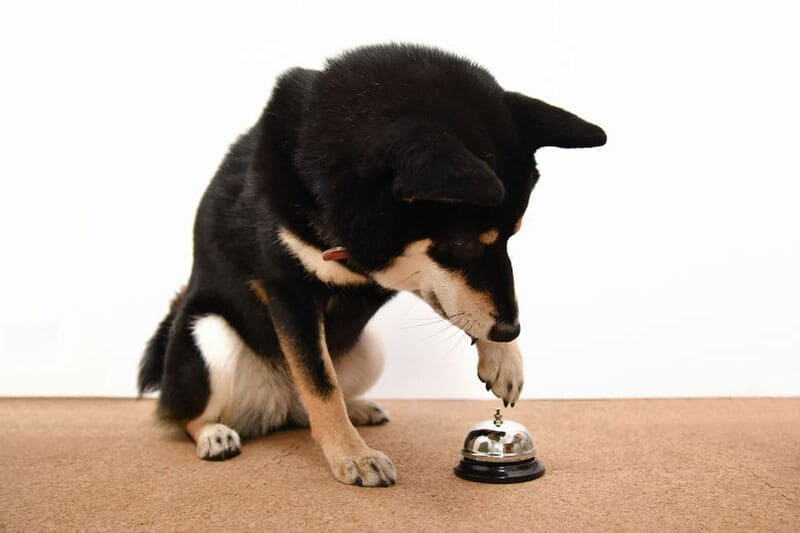
Ring a Bell
Important reminder: Before starting part 2 of this training guide, make sure your dog has completed part 1 and that he is already accustomed to the habit. Part 2 of this guide will act as a supplement that will make things easier for you and your pet.
Step 1: Place a Bell by the Door and Lure Your Dog Towards It
You may use a bell hanging at the door or a floor bell. Take a treat and let your dog smell it. As he tries to eat it from your hand, gently lead his nose to the bell.
Step 2: Reward Your Dog for Any Action Leading to the Bell
Reward your dog with a treat for a step or a turn of the head toward the bell. Reward him again with the treat and some verbal praise when he makes it to the bell and even makes some sounds out of it.
Repeat the exercise until your dog makes the association with the ringing of the bell and the reward.
Step 3: Add Opening the Door Simultaneously with Ringing the Bell
The progression to these steps may take a few days, or just a few sessions depending on your consistency. It may also depend on how quickly your dog can learn. As soon as he learns that the bell is equal to a treat, add the opening of the door to the sequence, after which reward whenever appropriate.
Repeat the exercise with treats, the bell, and the opening of the door.
Step 4: Fade Out the Treats
As your dog starts to master the behavior of ringing the bell to get the treats and have the door opened, gradually remove the food until all the reward is the door opening. Make it such that it becomes the reward itself.
Repeat the exercise.
Step 5: Add the Ringing of the Bell to the Your Potty Routine
Whenever you are getting your puppy out of his crate on his way to the potty in the morning, test his memory by setting him down and waiting for him to ring the bell. When he does so, immediately open the door and let him out into the potty area.
What If My Dog Keeps Ringing the Bell?
Do not associate the bell with going outside to play. This is to avoid confusing your dog. Stick to the routine for as long as possible until it becomes a habit. Every time he rings the bell take him out as if to go to the potty. Make sure that whenever he rings the bell you are only going out to wait for him to potty, if not, back to the house he goes.
At this stage, your dog may already be proficient with making sure that he does potty at the right place. For this particular habit or skill, you can act as a supervisor by just gently letting your dog know if he has peed in the right place or not. Don’t try to have him pee or poo on command. Just provide the place and routine to make it easier for you and your dog to manage his potty habits.
If things don’t seem to be working, be persistent and try again. Just continue taking your dog outside to the potty, whether he does or not.
Read also: How to Train a Puppy to Stop Begging
Teaching Your Dog to Bark to Go Out

Step 1: Reward Your Dog for Barking at Least Once
Take a squeaky toy and make noises with it in front of your dog to get him to bark. Reward him with a treat when he barks at least once.
Repeat the exercise until your dog associates 1 bark = 1 reward.
Step 2: Add the Command “Bark” to the Step 1 Exercise.
Repeat the exercise until your dog associates 1 bark plus the command “bark” from you = receiving a treat.
Step 3: Have Your Dog “Talk” to the Door
Have your dog bark at the door by giving him the command “bark” while facing it. When he barks at the door immediately reward him with a treat.
Repeat the exercise
Step 4: Add Opening the Door to the Reward for Barking at It
Have your dog bark at the door on cue and reward him with a treat. Then, open the door as well.
Repeat the exercise.
Step 5: Fade Out the Treats
This time, reward your dog for barking at least once without the treats and just opening the door and letting him out.
Repeat the exercise until your dog gets used to barking at least once to get you to open the door for him.
Troubleshooting: What Not to Do When Training Your Dog
- Do not punish your pet when he has “accidents” as it may disrupt his natural potty process. He may become timid and will resort to secretly peeing somewhere else because of fear.
- Try not to excite them when it’s poo time, as they might hold in.
- If your puppy doesn’t go, put him back in the crate, don’t let him loiter around or he might pee on the floor.
Read also: How to teach your dog to come when called
Help! My Dog Won’t Go Outside Without Me!
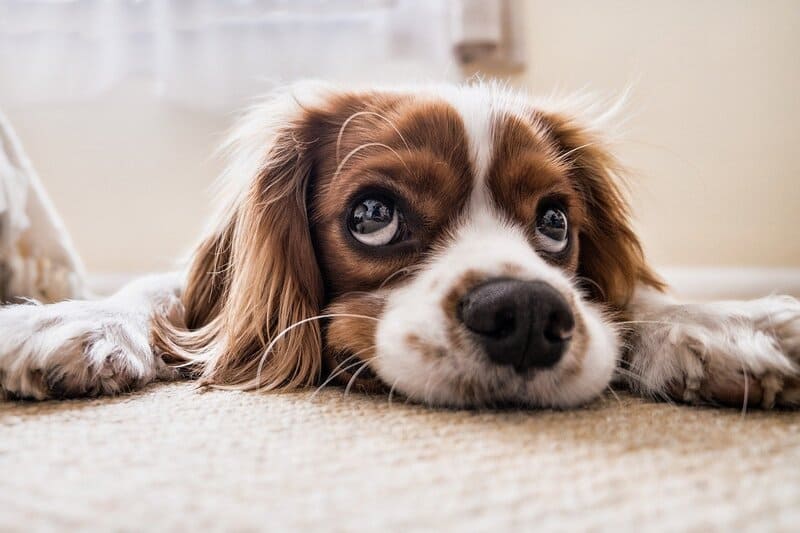
Note that there might be some reasons why your dog doesn’t want to go out alone. You must understand them first, and then try to identify the reasons why he can’t go outside on his own.
Here are some possible reasons:
- He may have had some scary experiences in the past with humans, cars, or other dogs
- He is not familiar with the strange sounds and sights of the outside world yet
- The dog might be sick
Either way, you will have to take some time to at least know the reason why he doesn’t want to go out alone. After which, you may gradually acclimate your dog again to the outdoors.
Step 1: Start with Small Spaces First
Try bringing him out to the backyard first. Then gradually make yourself scarce as he becomes more comfortable being alone in the backyard.
Step 2: Move on To Bigger Places
You can then bring him on to the front yard where he can see other people and other things making sounds and noises. He gets to experience all of this without getting too far from the house.
Step 3: Take Him Out to the Park
As he becomes more and more relaxed, start taking him out for walks to the park. Allow him to desensitize from all the action going on.
Step 4: Separate Yourself from Your Dog Indoors
Do the separation for short periods so as not to scare your dog that you’re suddenly totally gone. Once he gets used to not always seeing you around even when inside the house, you can then let him go out alone by opening the door.
Repeat Step 4 exercise until your dog can already have fun even if you are not outside with him.
Why Did My Old Dog Suddenly Stop Asking to Go Outside?
For a senior dog to suddenly have behavioral problems could mean that there is a physical issue. Your best option is to take him to the vet. It could be anything from arthritis to digestive problems, hearing, joint problems, and maybe even cognition issues. Get your older dog to the vet first before trying to retrain him.
How Long Does It Take to Housebreak Your Dog?
Since this is a daily occurrence, your dog should learn and remember it in 2 weeks. But then again, that’s just an average. It will depend on your willingness as a trainer/owner on how much time and consistency you put in.
Puppy
You can start training your puppy at 12-16 weeks old. This is so that you will allow them to have ample control of their bladder and bowel first before training them. There is no way you can predict when exactly your puppy will go at any given moment, but you can assist him to do it at the right place. You may have to do this training daily at 2-3 sessions per day. Then, take about 5 minutes per session.
The training itself may last anywhere between 2-3 weeks, depending on your dog’s progress.
Adult Dog
Your adult dog may also have to train daily at 2 sessions per day. Take about 10 minutes or less per session to give him enough time to go out. The training may also last for 2-3 weeks.
Train a senior dog like you would an adult dog and give him or her at least 1 month to complete, as he may have some unlearning to do first.

